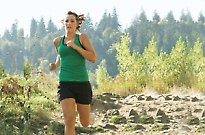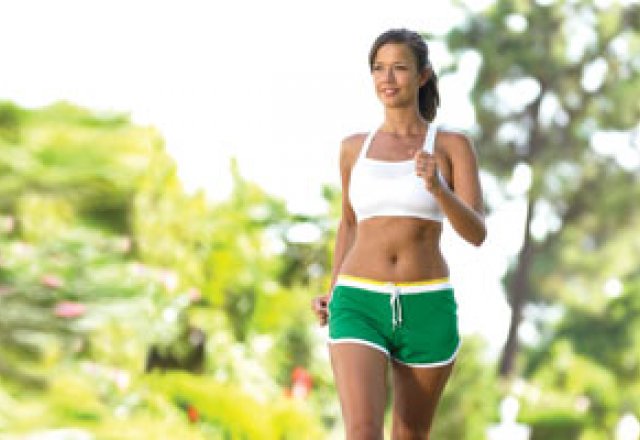
Exercise for your decade

Whatever your age your mind and body can benefit from a workout, but while hitting the gym can have enormous benefits in your 20s, pounding the treadmill at 60 is not advisable. Emma Krieger asks the experts what we should be doing at different stage
To help tailor your workout needs to your age, we chart the must-do’s and don’t-do’s for fitness throughout the decades.
The tenacious 20s
Your 20s are full of opportunity. Most 20-somethings are free from too much responsibility (think babies or top-of-the-food-chain jobs) so now is the time to make the most of your spare time with some hardcore training.
Unfortunately, however, a recent UK study shows 70 per cent of young women don’t exercise enough. To help kick start your motivation, try joining a gym with a friend or participating in regular boot camps.
“Group training provides accountability,” says personal trainer Christine Shorten, “and is a great way of guilting you into working out when you’d rather stay plonked on the couch!”
Fortunately, if boredom is a factor, youth is on your side as you should be able to do pretty much whatever exercise you like. Try everything while you can and decide where your forté lies – whether it’s Zumba, marathon running, yoga, triathlon, indoor rock-climbing or horseback riding.
Shorten advises working out up to five or six days a week, with three days spent focusing on cardiovascular training (such as jogging, vigorous walking or cycling) and two or three days of weight training. And make the most of it: your heart and lung capacities, which enable you to exercise aerobically, start a downward trend from 25-plus.
“At this age you're building for the future in terms of your bone density, muscle strength and cardiovascular health,” Shorten says. “So the more exercise you can do, the better."
Stay thoroughly fit through your 30s
“Your 30s are often the busiest time of your life,” says fitness trainer Donal Carr. “You're probably working longer hours and may be juggling the responsibilities of marriage and kids, so the last thing on your mind is exercise.”
But, unfortunately, once the big three zero arrives, the kilos start to creep on – regardless of whether you change your eating or exercising habits.
“Women lose around one per cent of muscle mass every year after turning 30,” says Carr. “Less muscle mass means fewer kilojoules burned, making it harder to achieve high fitness levels.”
The aim is to increase your cardio. “Interval training is the best tool for keeping the weight off in this decade and staying fit,” says Carr. “Base your interval training on a work:rest ratio of 20:10 – 20 seconds flat-out work, then 10 seconds rest.”
Running is a great way to get the most benefits in the least amount of time. Carr also recommends working out in the morning, as this will rev up your metabolism for the entire day and allow you to squeeze your training into your already jam-packed schedule.
Weight training is also important. “Weight training with heavier weights will help you develop more muscle mass – which is precisely what you're starting to lose,” says Carr. “The more muscle you can create now, the more efficient your metabolism will be.”
Also try and up your 'incidental' exercise at this age, such as walking to work instead of driving or lifting light hand weights while talking on the phone.
Fit and fighting 40s
Once you hit your 40s, your metabolism seriously starts to slow down and muscle mass begins to decrease significantly, so weight training becomes increasingly important.
“Strength training can replace lost muscle, get the body's metabolism back up and keep weight off permanently,” says Shorten.
“If you're trying to gain muscle tone, your workout should also involve a good amount of cardio. Choose an activity you like doing such as walking, swimming or running.”
It’s important to stay active now with the onset of perimenopause – the period in a woman's life just before menopause. “As oestrogen levels decline, fat storage settles at the abdomen making more fat circulate close to the heart – a leading cause of heart disease.”
Focus on 45 to 60 minutes of moderately paced aerobic workouts three to five times per week, which also “helps relieve stress and improve sleep,” says Shorten. Both of which are important at this life stage.
Flex it in your 50s
Menopause and post-menopausal symptoms usually surface in your 50s and often include weight changes, insomnia, high blood pressure, hot flushes and stress. But research has shown that gentle exercise can reduce these symptoms.
Because your flexibility drops at this age, stretching is increasingly important. For all-round fitness, aerobic exercise is best. Swimming is especially good for this decade as it places less stress on the skeletal system as “weight is supported by the water and shock to tissues and joints is avoided,” says Carr.
Working with light weights is good as older muscle responds to training by getting stronger, leaner and more pliable.
If you’re starting to panic about having neglected your fitness until now, it’s never too late to get active, however, do be careful. “Those who take up some form of exercise after years of doing nothing can become overzealous and treat their body like a 20-something,” warns Carr.
“If this is you, take things slowly – a complete physical might be necessary for those who have not exerted themselves in a while. Remember, you will not improve as fast as a younger person will, so don't get discouraged.”
The only way is slowly but surely. Start with half an hour twice a week. Then, as you increase in fitness and confidence, increase to three times a week.
Stay spritely at 60+
Your golden years don’t allow for a complete knock off in psychical activity. In fact, researchers have found that if you exercise in your 60s – even as little as once a week – you will live longer than those who don't stay active. Keep up your cardiovascular activities. Walking, swimming and even gardening are great, as they all raise the heart rate, helping to reduce hardening of the arteries. Also make sure you focus on strength training and core exercises to increase your stability.
“As you get older, you want to avoid falls and the risk of bone fractures, which can become more prevalent,” says Carr. “Yoga and tai chi are great for improving your flexibility and balance.
And remember, light exercise is not just good for the body, it keeps the mind active too.”
Keep your health and wellbeing in check with Nutrients Direct full range of supplements, proteins, natural formulas and more. Choose from their extensive range based on your goals and perform at your highest level.
NEXT: Looking for more natural ways to curb inflammatory? Check out these top anti-inflammatory foods.


